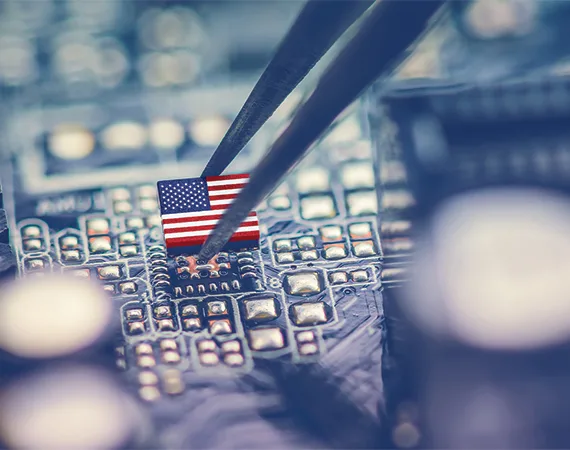Brad Ferguson has a stark warning for those who think the supply chain crisis is over. Ferguson is the chief government affairs officer for Bloomington-based SkyWater Technology, a semiconductor co-developer and producer. He knows his industry, which lies at the heart of supplying any item with an on/off switch, remains vulnerable.
“If China were to attempt reunification, the result may intentionally or unintentionally reduce the semiconductor output from Taiwan that the world has come to rely on, potentially making the COVID-related disruption look minor by comparison,” Ferguson says.
It would be easy to become complacent about supply chains. Once nearly-empty auto dealership lots are full, appliances are available in all shapes, sizes and colors, and electronics are promised with next-day delivery. But because China and Taiwan supply such a huge percentage of chips globally, tension in that region means manufacturers everywhere could see a repeat of the COVID-era supply chain chaos.
For manufacturers that require semiconductors for their final products, or in the equipment needed to make those products, help is on the way. Eager to avoid a future semiconductor-related supply chain crisis, Congress last August passed and President Biden signed into law the CHIPS and Science Act, which aims to boost domestic production of semiconductors.
The law provides more than $52.7 billion for American semiconductor research, development, manufacturing and workforce development. Specifically, CHIPS authorizes $39 billion in manufacturing incentives, including $2 billion for legacy chips used in automobiles and defense systems; $13.2 billion in research and development and workforce development; and $500 million for international information communications technology security and semiconductor supply chain activities.
A complex and booming market
While COVID-19 helped expose the precarious nature of international supply chains, it also boosted demand for high-tech products.
“The pandemic underscored the importance of semiconductors for remote work, telehealth, and rapid vaccine development, among many other areas,” says Ferguson.
SkyWater is one of several technology companies that grew out of Control Data, a pioneer in the mainframe computer industry that operated in Minnesota from 1957-1992. Ferguson says the semiconductor industry is poised for enormous growth in the coming years. “For the first 75 years since the invention of the transistor, the demand has grown to $500 billion annually. Experts estimate demand will more than double in the next seven years,” he says.
U.S.-based semiconductor firms operate in a complex market, where the U.S. still dominates the design, intellectual property and equipment aspects of the industry but actually produces a small percentage of chips. Instead, manufacturing has been outsourced to overseas production facilities to a great extent.
Taiwan has developed a truly dominant chip manufacturing sector — experts estimate more than half the world’s semiconductors are assembled there. Another 20-25% of semiconductors are produced in China.
Closing the gap between international and domestic production will take time and significant investment, but doing so is critical for supply stability and national and economic security.
Creating a level playing field
Across all industries, growing reliance on overseas manufacturers since the early 2000s has been driven by cost. Sourcing part or all of a product from lower-cost countries has boosted profits for companies and kept prices down for consumers. Shifting some portion of production back to the U.S., where costs are higher, will be a challenge.
The CHIPS and Science Act hopes to address that concern, creating financial incentives that would erase some of those cost differences. Companies like SkyWater, which already produces all of its semiconductors in the U.S., are well-positioned to take advantage of the legislation.
“We are excited about the potential to increase scale, output, and employment from the manufacturing incentives in the program,” Ferguson says.
In addition, the legislation provides funding for companies that are in a position to develop avenues to bridge the so-called “valley of death” from technology concept to production. Because of SkyWater’s work on creating a seamless process from idea to final product, Ferguson believes his company is competitive for this aspect of funding. “There are many elements of this program that are well-aligned with what SkyWater has been building over the past five years,” he says.
Ferguson also applauds the 25% tax credit for semiconductor investments to partially offset the large incentives already offered overseas for semiconductors as the impetus to move manufacturing back home. “Hopefully that will start to level the global playing field,” he says.
Averting another supply chain crisis
While the CHIPS Act will directly and immediately impact semiconductor manufacturing firms, the legislation ultimately aims to benefit all manufacturers that use chips. Ferguson notes that while end-product manufacturers should have multiple sourcing options for semiconductors, it is also important to have a U.S. source for semiconductors, for national and economic security reasons.
“What COVID taught us all is the importance and fragility of the semiconductor supply chain for nearly all industries,” Ferguson says, citing idled assembly lines, lost jobs and billions of dollars in lost productivity as manufacturers waited for the delivery of semiconductors from overseas. “Investing in U.S. manufacturing will help to buffer our economy against such disruptions.”



